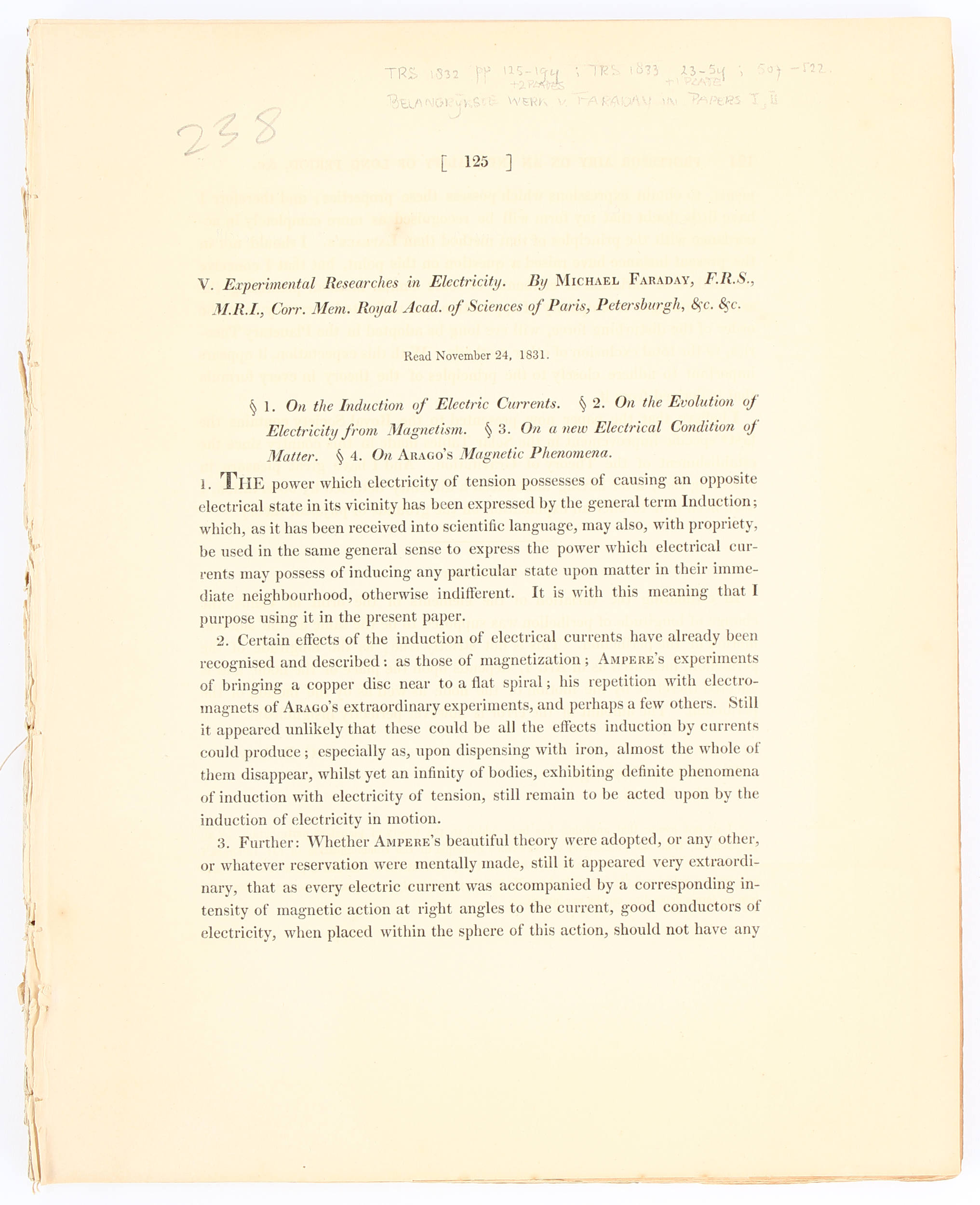FARADAY, Michael (1791-1867). "Experimental Researches in Electricity." 11 offprints from the Philosophical Transactions , Series 19-29. London: 1846-1852. 6 volumes, 4 o (300 x 230 mm). 3 engraved plates by Basire, one folding, wood-engraved text diagrams. (Some mostly marginal soiling, foxing to plates, stain to last volume containing series 29, obscuring several words on first 8 pages.) Stab-stitched in original plain wrappers, series 23 and 26-27 partly unopened (worn and soiled, lacking back wrapper to last volume); cloth folding case. Provenance : Sir William Thomson first Baron Kelvin (1824-1907), physicist (author's presentation inscription on title-page of Series 22 [1849]); Series 23 (1850) and 29 (1852) also inscribed by Faraday, to the "President of the [Royal] Coll[ege of] Physicians" and to "St. Panc[ras?] President [illegible]" respectively; Series 28 inscribed on front wrapper "Rec'd from author April 1852" in an unidentified hand; "Duplicate" written in later pencil on all front wrappers. FIRST EDITIONS, offprint issues, of which three PRESENTATION COPIES, ONE INSCRIBED TO WILLIAM THOMSON later Lord Kelvin. This inscription links two of the dominant figures in 19th-century physics. Not only did Thomson's investigations of electromagnetism build directly on Faraday's achievements, but Thomson had crucially influenced Faraday's most important research: "The last, and in many ways the most brilliant, of Faraday's series of researches was stimulated by the quite specific comments of one of the few people who thought his theory of electricity worthy of serious attention. On 6 August 1845, William Thomson the future Lord Kelvin, addressed a lengthy letter to Faraday, describing his success with the mathematical treatment of the concept of the line of force. At the end of the letter Thomson listed some experiments to test the results of his reasonings on Faraday's theory, and it was this that pushed Faraday once more into active scientific research" (DSB). Faraday's efforts to duplicate an effect predicted by Thomson in this same letter led directly to his discovery, in September 1845, of the magnetic properties of all matter, which he divided into two categories, "paramagnetics" and "diamagnetics" according to their tendencies of magnetic alignment. The paper inscribed to Thomson relates to the latter group, exemplified by bismuth. Many attempts were made by Faraday's contemporaries to explain this phenomenon, but none were satisfactory. "Only one point emerged clearly, and this point was of fundamental importance. Whatever the cause of magnetism, the manifestation of magnetic force took place in the medium surrounding the magnet. This manifestation was the magnetic field and the energy of the magnetic system was in the field, not in the magnet. By extension, the same could be said (and was said by Faraday) of electrical and gravitational systems. This is the fundamental axiom of classic field theory" (DSB), constructed a few years later by James Clerk Maxwell on Faraday's foundations. (6)
FARADAY, Michael (1791-1867). "Experimental Researches in Electricity." 11 offprints from the Philosophical Transactions , Series 19-29. London: 1846-1852. 6 volumes, 4 o (300 x 230 mm). 3 engraved plates by Basire, one folding, wood-engraved text diagrams. (Some mostly marginal soiling, foxing to plates, stain to last volume containing series 29, obscuring several words on first 8 pages.) Stab-stitched in original plain wrappers, series 23 and 26-27 partly unopened (worn and soiled, lacking back wrapper to last volume); cloth folding case. Provenance : Sir William Thomson first Baron Kelvin (1824-1907), physicist (author's presentation inscription on title-page of Series 22 [1849]); Series 23 (1850) and 29 (1852) also inscribed by Faraday, to the "President of the [Royal] Coll[ege of] Physicians" and to "St. Panc[ras?] President [illegible]" respectively; Series 28 inscribed on front wrapper "Rec'd from author April 1852" in an unidentified hand; "Duplicate" written in later pencil on all front wrappers. FIRST EDITIONS, offprint issues, of which three PRESENTATION COPIES, ONE INSCRIBED TO WILLIAM THOMSON later Lord Kelvin. This inscription links two of the dominant figures in 19th-century physics. Not only did Thomson's investigations of electromagnetism build directly on Faraday's achievements, but Thomson had crucially influenced Faraday's most important research: "The last, and in many ways the most brilliant, of Faraday's series of researches was stimulated by the quite specific comments of one of the few people who thought his theory of electricity worthy of serious attention. On 6 August 1845, William Thomson the future Lord Kelvin, addressed a lengthy letter to Faraday, describing his success with the mathematical treatment of the concept of the line of force. At the end of the letter Thomson listed some experiments to test the results of his reasonings on Faraday's theory, and it was this that pushed Faraday once more into active scientific research" (DSB). Faraday's efforts to duplicate an effect predicted by Thomson in this same letter led directly to his discovery, in September 1845, of the magnetic properties of all matter, which he divided into two categories, "paramagnetics" and "diamagnetics" according to their tendencies of magnetic alignment. The paper inscribed to Thomson relates to the latter group, exemplified by bismuth. Many attempts were made by Faraday's contemporaries to explain this phenomenon, but none were satisfactory. "Only one point emerged clearly, and this point was of fundamental importance. Whatever the cause of magnetism, the manifestation of magnetic force took place in the medium surrounding the magnet. This manifestation was the magnetic field and the energy of the magnetic system was in the field, not in the magnet. By extension, the same could be said (and was said by Faraday) of electrical and gravitational systems. This is the fundamental axiom of classic field theory" (DSB), constructed a few years later by James Clerk Maxwell on Faraday's foundations. (6)














Testen Sie LotSearch und seine Premium-Features 7 Tage - ohne Kosten!
Lassen Sie sich automatisch über neue Objekte in kommenden Auktionen benachrichtigen.
Suchauftrag anlegen